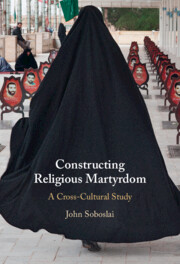Book contents
- Constructing Religious Martyrdom
- Constructing Religious Martyrdom
- Copyright page
- Dedication
- Contents
- Acknowledgments
- Abbreviations of Ancient Sources
- 1 Introduction
- 2 Executed Martyrs in Second-Century Christianity
- 3 The Human Bombs of Twentieth-Century Shi’i Islam
- 4 Sikh Martyr Imaginaries during World War I
- 5 Twenty-First-Century Tibetan Self-Immolators
- 6 Performances of Suffering
- 7 Witnesses to a Sovereign Imaginary
- Epilogue
- Bibliography
- Index
5 - Twenty-First-Century Tibetan Self-Immolators
Published online by Cambridge University Press: 07 June 2024
- Constructing Religious Martyrdom
- Constructing Religious Martyrdom
- Copyright page
- Dedication
- Contents
- Acknowledgments
- Abbreviations of Ancient Sources
- 1 Introduction
- 2 Executed Martyrs in Second-Century Christianity
- 3 The Human Bombs of Twentieth-Century Shi’i Islam
- 4 Sikh Martyr Imaginaries during World War I
- 5 Twenty-First-Century Tibetan Self-Immolators
- 6 Performances of Suffering
- 7 Witnesses to a Sovereign Imaginary
- Epilogue
- Bibliography
- Index
Summary
In Chapter 5, the final case study examines the spate of Tibetans burning themselves alive in opposition to rule by the People’s Republic of China (PRC) since 2009. First delineating significant events in the relationship between the nation of Tibet and the PRC, prior to and through the Cultural Revolution, I describe the social, political, and cultural situation of Tibetans during their loss of their sovereign nation. Interrogating the most attested claims and desires of these self-immolators—called pawo or martyrs in Tibetan circles—I highlight the role Tibetan Buddhism plays in the conflict as target of the PRC, core of Tibetan identity, and solution to the crisis on the plateau. I connect that discussion to an analysis of the historical and religious bases for the practice of auto-cremation as a means of resistance and meritorious action. Drawing these arguments together, I conclude by describing the state of emergency within Tibet, most notable in lands which now exist within the internationally recognized borders of China. I conclude by showing how suffering is constructed as an affirmation of the truth of the Tibetan imaginary made plain in the burned bodies of pawo.
Keywords
- Type
- Chapter
- Information
- Constructing Religious MartyrdomA Cross-Cultural Study, pp. 272 - 322Publisher: Cambridge University PressPrint publication year: 2024

